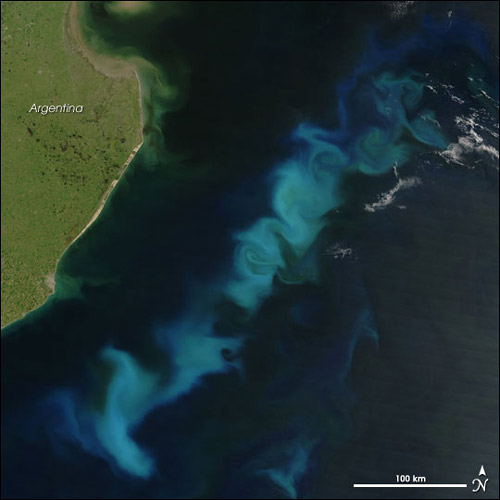Plan to Dump Iron in Ocean Criticized

A controversial plan to dump iron dust into the open ocean near the Galapagos Islands to induce the growth of phytoplankton met with opposition from an environmental group today.
The plan, from a company called Planktos, Inc., seeks to grow the tiny creatures in an attempt to suck up excess atmospheric carbon dioxide.
Iron dust can stimulate the growth of microscopic marine plants that in turn use carbon dioxide taken from the atmosphere to fuel photosynthesis.
While phytoplankton in the ocean already absorb some of the greenhouse gas, some scientists have theorized that dumping iron into the ocean could allow it to become a more effective carbon sink, which is exactly the idea that Planktos, Inc, a for-profit company, plans to test.
But others, including the World Wildlife Fund, are skeptical about the impact this dumping could have on other marine life.
“There are much safer and proven ways of preventing or lowering carbon dioxide levels than dumping iron in the ocean,” said Lara Hansen, chief scientist with the WWF International Climate Change Program. “This kind of experimentation with disregard for marine life and the lives of people who rely on the sea is unacceptable.”
Possible consequences
Get the world’s most fascinating discoveries delivered straight to your inbox.
WWF scientists argue that the Planktos experiment could result in a shift in the composition of species that make up the plankton, which is the base of the marine food chain.
Of particular concern to the WWF, the largest multinational conservation organization in the world, are the 400 species of fish that swim off the Galapagos coast, and the turtles, penguins, marine iguanas and other animals that inhabit the islands, many of which are found nowhere else in the world.
“World Wildlife Fund’s concern extends beyond the impact on individual species and extends to the changes that this dumping may cause in the interaction of species, affecting the entire ecosystem,” said microbiologist Sallie Chisholm, a WWF board member. “There’s a real risk that this experiment may cause a domino effect through the food chain.”
Russ George, the CEO of Planktos, Inc., counters that the very reason why the Galapagos Islands have the rich array of life that they do is because of the iron that drains from the islands into the ocean.
“The Galapagos bloom is one of the most famous features on the planet,” George said.
He says that the Galapagos bloom is much larger than the one his group will be creating, and will actually serve as a control for their experiment, which will be conducted several hundred miles west of the island chain. George adds that they will be putting far less iron into the ocean than what comes from the Galapagos to create the famous bloom.
“No amount of iron that humans could add to the ocean could meet with what the Galapagos puts in the ocean,” George told LiveScience.
The WWF also argues that the gases released by the phytoplankton blooms and the bacteria that eat the plants after they die could have a negative effect. The bacterial decay could also consume oxygen and alter the levels of the gas in the water column, which could favor the production of microbes that emit potent greenhouse gases, like nitrous oxide (commonly known as “laughing gas”).
George said that several environmental organizations have criticized his company’s experiments, though other scientific organizations have conducted, or plan to conduct, similar experiments. He added that none of the potential consequences cited by the WWF and other groups have been seen in previous experiments.
According to researchers at the Woods Hole Oceanographic Institution in Massachusetts, who have conducted such experiments, it is uncertain whether or not iron fertilization will actually substanitally reduce atmospheric carbon dioxide.
Cataclysmic collapse
Far from harming marine life, George says, the plans of iron enrichment will actually revitalize phytoplankton, whose numbers have been steadily dropping over the last couple decades, as was reported in a Dec. 7 paper in the journal Nature.
“The plant life in the ocean is collapsing at a rate of 1 percent per year,” the same amount of decline as is seen in terrestrial rainforests, George said.
But the total amount of decline in phytoplankton biomass is equivalent to the disappearance of all the rainforests on Earth, George said, and which he describes as “an absolute cataclysmic state of collapse.”
George argues that iron enriching efforts are simply returning missing nutrients restoring the plant life to their previous levels.
The WWF's Chisholm countered that plankton productivity is not static and that estimates showing decreases are based on indirect surface measurements that don't include plankton deeper in the water column.
"So there is not enough evidence to warrant such extreme measures, which do not mimic natural processes, and are ephemeral," Chisholm told LiveScience in an email.
- Top 10 Ways to Destroy Earth
- Timeline: The Frightening Future of Earth
- Top 10 Emerging Environmental Technologies

Andrea Thompson is an associate editor at Scientific American, where she covers sustainability, energy and the environment. Prior to that, she was a senior writer covering climate science at Climate Central and a reporter and editor at Live Science, where she primarily covered Earth science and the environment. She holds a graduate degree in science health and environmental reporting from New York University, as well as a bachelor of science and and masters of science in atmospheric chemistry from the Georgia Institute of Technology.


